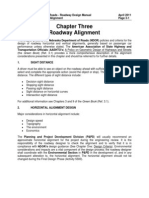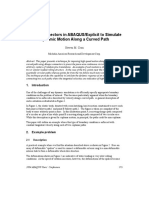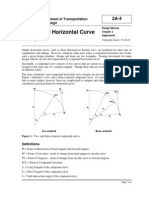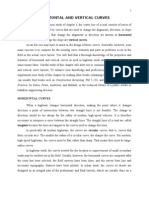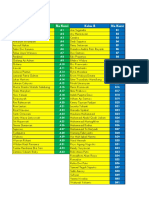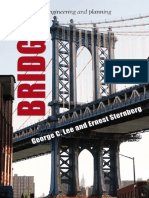Reverse Curve Design: Iowa Department of Transportation Office of Design
Reverse Curve Design: Iowa Department of Transportation Office of Design
Uploaded by
phriquenziCopyright:
Available Formats
Reverse Curve Design: Iowa Department of Transportation Office of Design
Reverse Curve Design: Iowa Department of Transportation Office of Design
Uploaded by
phriquenziOriginal Title
Copyright
Available Formats
Share this document
Did you find this document useful?
Is this content inappropriate?
Copyright:
Available Formats
Reverse Curve Design: Iowa Department of Transportation Office of Design
Reverse Curve Design: Iowa Department of Transportation Office of Design
Uploaded by
phriquenziCopyright:
Available Formats
Iowa Department of Transportation Office of Design
2D-1
Design Manual Chapter 2 Alignments Originally Issued: 09-22-00
Reverse Curve Design
This section provides information pertaining to the design of reverse curves. Reverse curves are commonly used to redirect through lanes at channelized intersections and high-speed median crossovers. They are also utilized in interchange ramps and to realign crossroads at skewed intersections. A reverse curve is two circular curves with opposite deflection angles. The curves may have equal or unequal radii and/or deflection angles. The curves may be continuous or separated by a short tangent section, see Figure 1. The tangent length is normally determined by superelevation transition requirements. Each of the curves in a reverse curve is treated in a similar manner as a horizontal curve (see Section 2A-1).
Figure 1: Reverse curves without and with a tangent section between.
Lane Redirection
Channelized Intersections At channelized intersections with redirected through lanes, a PRC (Point of Reverse Curve) is preferred because superelevation is undesirable. In most cases, the radii R1 and R2, and deflection angles 1 and 2 will be the same, as will the deflection angles. The designer may take advantage of this symmetry to reduce calculations. Minimum radii are selected based upon maintenance of normal crown cross slopes at design speed. Median Crossovers Reverse curves in median crossovers are separated by a short tangent section from PT1 to PC2 (see Figure 1) that allows the superelevation to transition from the slope of Curve 1 to the slope of
Page 1 of 3
Chapter 2Alignments
Curve 2. Determining the length of this tangent is the first step in designing the reverse curve. The minimum length of this tangent will be equal to the superelevation tangent runout length (x) of Curve 1 plus the superelevation tangent runout length (x) of Curve 2. Sections 2A-2 and 2A-3 of this manual provide more information concerning superelevation and Section 3E-3 provides more information regarding median crossovers. The designer is encouraged to consult the Methods Section in the Office of Design for further assistance with median crossover design.
Interchange Ramps
Reverse curves are used on interchange ramps when necessary. Tangent sections between the curves are required to accommodate the high-speed superelevation transitions. The minimum tangent length between the curves is equal to the sum of 70% of the tangent runoff length (L) for each curve. More specific criteria for reverse curve interchange ramps will be detailed in a section to be issued in the future.
Realignment of Crossroads
Reverse curves may also be used when realigning crossroads to reduce skew. Refer to Section 6A-8 of this manual for more details concerning intersection alignment.
Example: Lane Redirection at an Intersection
Given a design speed of 50 mph and a lane width of 12, we wish to design a reverse curve to redirect a through lane to accommodate a 16 median for a left turn lane, as seen in Figure 2. Assume a normal crown (NC) section.
Figure 2: Reverse curve used to redirect a through lane at an intersection.
1. Simplify calculations by setting R1 and R2 in Figure 1 equal to each other. Parallel offsets result in 1 and 2 being equal to each other. This produces the situation illustrated in Figure 3.
Figure 3: Reverse curve for lane redirection in example problem.
Page 2 of 3
Section 2D-1Reverse Curve Design
2. Using Table 1 in Section 2A-3 with a normal crown (NC), R = 8000 feet. 3. Since the median is 16, d in Figure 3 is 16. With trigonometry it can be shown that cos =
2R d from which = 2.562559 (23345.21). 2R
4. Using the formulas in Section 2A-1 with R and as knowns, the remaining circular components may be calculated: T = R tan L=
= 178.93 2
R = 357.80 180
E = T tan
= 2.00. 4
This information will be identical for both curves in the reverse curve. 5. The total length (TL) for the reverse curve can be calculated with the following formula:
TL =
(R1 + R2 )2 (R1 + R2 d )2
= 715.36
Page 3 of 3
You might also like
- 09K K1 DrumDocument3 pages09K K1 Drumnavifreak0100% (3)
- Setting Out of Transition CurvesDocument13 pagesSetting Out of Transition CurvesapurvajahagirdarNo ratings yet
- Calculus and Vectors - Chapter 1Document68 pagesCalculus and Vectors - Chapter 1myobNo ratings yet
- Soal Reading Dan PembahasannyaDocument9 pagesSoal Reading Dan PembahasannyaDonie Syah SiregarNo ratings yet
- SUG 306 Engineering Surveying II - Docx-1Document37 pagesSUG 306 Engineering Surveying II - Docx-1Joshua Oluwadamilare100% (2)
- New and Improved Unsymmetrical Vertical Curve For Highways: Said M. EasaDocument7 pagesNew and Improved Unsymmetrical Vertical Curve For Highways: Said M. EasaLourd FirstNo ratings yet
- Design of Highway Horizontal Alignment: Dr. Taleb M. Al-RousanDocument38 pagesDesign of Highway Horizontal Alignment: Dr. Taleb M. Al-RousanPenelope MalilweNo ratings yet
- GEE142 - Module 1Document7 pagesGEE142 - Module 1WENARD SESUELOSNo ratings yet
- Horizontal Curves: San Antonio CollegeDocument17 pagesHorizontal Curves: San Antonio CollegeBadri DadiNo ratings yet
- Land Surveying - CurvesDocument13 pagesLand Surveying - CurvesitsflairNo ratings yet
- Chapter Three Roadway AlignmentDocument36 pagesChapter Three Roadway AlignmentKadir VasioğluNo ratings yet
- Drawing Cam Displacement DiagramDocument2 pagesDrawing Cam Displacement DiagramcisnarFNo ratings yet
- CEHR0313-Mod2 3 2Document27 pagesCEHR0313-Mod2 3 2Kei KagayakiNo ratings yet
- Horizontal CurvesDocument22 pagesHorizontal Curvesapi-281761923No ratings yet
- Use of Connectors in ABAQUS/Explicit To Simulate Dynamic Motion Along A Curved PathDocument15 pagesUse of Connectors in ABAQUS/Explicit To Simulate Dynamic Motion Along A Curved PathTina LoweNo ratings yet
- Connect Intersecting Gradients in The Vertical PlaneDocument8 pagesConnect Intersecting Gradients in The Vertical PlaneuipohlklgfNo ratings yet
- Chapter 1 CurvesDocument47 pagesChapter 1 Curvesaduyekirkosu1scribdNo ratings yet
- Compound CurveDocument4 pagesCompound CurveChery Davalos Dote100% (2)
- Horizontal and Vertical CurvesDocument29 pagesHorizontal and Vertical CurvesSandro SorianoNo ratings yet
- Applications of HzVert CurvesDocument5 pagesApplications of HzVert CurvesteamNo ratings yet
- CurvesDocument57 pagesCurvesTahir Mubeen100% (2)
- AlignmentsDocument16 pagesAlignmentsdare ogunsolaNo ratings yet
- Lecture 6 The Alignment VerticalDocument18 pagesLecture 6 The Alignment VerticalAbdulaziz AbdiNo ratings yet
- Highways Midterm Part 2Document12 pagesHighways Midterm Part 2Hubert EnzooNo ratings yet
- Broken Back CurDocument4 pagesBroken Back CurSeason Ch'ngNo ratings yet
- Curve RangingDocument23 pagesCurve RangingYounq KemoNo ratings yet
- Optimization of Radial Impeller Geometry PDFDocument28 pagesOptimization of Radial Impeller Geometry PDFomarihuanoNo ratings yet
- Cara Menghitung Dimensi Runner Turbin AirDocument24 pagesCara Menghitung Dimensi Runner Turbin AirPasbon Da SilvaNo ratings yet
- Superelevation Calculation (New Standard)Document16 pagesSuperelevation Calculation (New Standard)jkrlos_188441No ratings yet
- Superelevation Calculation (New Standard) PDFDocument16 pagesSuperelevation Calculation (New Standard) PDFsahriNo ratings yet
- Fin TH Machines 3Document9 pagesFin TH Machines 3getaby4uNo ratings yet
- Curve NoteDocument13 pagesCurve NotePuneet AggarwalNo ratings yet
- 5 CE222F-18 Fieldworks 5 - Reverse CurveDocument8 pages5 CE222F-18 Fieldworks 5 - Reverse CurveJoana Marie RemoNo ratings yet
- Lecture 4 The Alignment HorizontalDocument22 pagesLecture 4 The Alignment HorizontalAbdulaziz AbdiNo ratings yet
- Chapter 5 - CurvesDocument24 pagesChapter 5 - CurvesHassan YousifNo ratings yet
- 3A1 Lecture 13Document46 pages3A1 Lecture 13apurvajahagirdarNo ratings yet
- 3-02 (2014 Dec)Document34 pages3-02 (2014 Dec)Samira AhangariNo ratings yet
- Route TD For All Student Learner's Highway EngineeringDocument25 pagesRoute TD For All Student Learner's Highway Engineeringkrishy19sNo ratings yet
- CIV3703 Transport Engineering (USQ)Document58 pagesCIV3703 Transport Engineering (USQ)hao baiNo ratings yet
- Survey Methods CalculationsDocument15 pagesSurvey Methods CalculationsHamed YousifNo ratings yet
- Full 64256 Ok OkDocument8 pagesFull 64256 Ok OkmghgolNo ratings yet
- Surveying Problems PDFDocument70 pagesSurveying Problems PDFCharisse RiveraNo ratings yet
- 01 CE222 18 Learnign Module 1 Higway Curves - 2CE 1Document12 pages01 CE222 18 Learnign Module 1 Higway Curves - 2CE 1Isaiah Danniel PerezNo ratings yet
- Curves-I: An Edusat Lecture OnDocument49 pagesCurves-I: An Edusat Lecture Onmapasure75% (4)
- L6 - Curves Ranging PDFDocument43 pagesL6 - Curves Ranging PDFAinur NasuhaNo ratings yet
- 2 Notes TWO HORIZONTAL CURVESDocument24 pages2 Notes TWO HORIZONTAL CURVESfosuohenefrankjnrNo ratings yet
- CNC Interpolators: Algorithms and AnalysisDocument10 pagesCNC Interpolators: Algorithms and AnalysisPham LongNo ratings yet
- Curves: Definition and Types - Curves - SurveyingDocument55 pagesCurves: Definition and Types - Curves - SurveyingAderiyike noahNo ratings yet
- Cam MechDocument24 pagesCam MechmarcglebNo ratings yet
- The Robinson CalculatorDocument13 pagesThe Robinson CalculatorRobert Adams100% (1)
- Curve RangingDocument15 pagesCurve RangingSomadina AnaeduNo ratings yet
- Analog Dialogue, Volume 48, Number 1: Analog Dialogue, #13From EverandAnalog Dialogue, Volume 48, Number 1: Analog Dialogue, #13Rating: 4 out of 5 stars4/5 (1)
- Planar Linkage Synthesis: A modern CAD based approachFrom EverandPlanar Linkage Synthesis: A modern CAD based approachNo ratings yet
- Power Systems-On-Chip: Practical Aspects of DesignFrom EverandPower Systems-On-Chip: Practical Aspects of DesignBruno AllardNo ratings yet
- Robot Manipulators: Modeling, Performance Analysis and ControlFrom EverandRobot Manipulators: Modeling, Performance Analysis and ControlNo ratings yet
- Cylindrical Compression Helix Springs For Suspension SystemsFrom EverandCylindrical Compression Helix Springs For Suspension SystemsNo ratings yet
- Characteristic Modes: Theory and Applications in Antenna EngineeringFrom EverandCharacteristic Modes: Theory and Applications in Antenna EngineeringNo ratings yet
- Mmrda PDFDocument13 pagesMmrda PDFTufailAhmedNo ratings yet
- Introduction À L'economie Et Comptabilité Nationale L1 2023Document228 pagesIntroduction À L'economie Et Comptabilité Nationale L1 2023souldjaogofficiel22No ratings yet
- 2015 Annual Report - The Pace of NatureDocument16 pages2015 Annual Report - The Pace of NatureAbraham Path InitiativeNo ratings yet
- Steady State Handling: B C D FDocument5 pagesSteady State Handling: B C D FFabio MiguelNo ratings yet
- Expression of Interest GMADADocument30 pagesExpression of Interest GMADAchithiraNo ratings yet
- Noise PollutionDocument7 pagesNoise PollutionAvdhesh ChauhanNo ratings yet
- Cost Calculation of Jamtara-Dumka ProjectDocument24 pagesCost Calculation of Jamtara-Dumka ProjectnsureshbabuNo ratings yet
- Alan Williams-Steel Structures Design ASD - LRFD-McGraw-Hill (2011)Document4 pagesAlan Williams-Steel Structures Design ASD - LRFD-McGraw-Hill (2011)aldincrump100% (1)
- Malaysia Rear Seatbelt CampaignDocument7 pagesMalaysia Rear Seatbelt Campaignsathiyaa80% (1)
- CALTRANS-Cost Estimates PDFDocument24 pagesCALTRANS-Cost Estimates PDFGeorge AlexiadisNo ratings yet
- Data No Kursi 16 & 17 Jan 2015 Batch 2015-4Document3 pagesData No Kursi 16 & 17 Jan 2015 Batch 2015-4elearninglsprNo ratings yet
- Presentation Integrated Infrastructure PlanningDocument123 pagesPresentation Integrated Infrastructure PlanningSushmitha NagarajanNo ratings yet
- Road Safety: Points Hitherto Seldom Noticed: - Atul Kumar Ahuja NSS Program OfficerDocument91 pagesRoad Safety: Points Hitherto Seldom Noticed: - Atul Kumar Ahuja NSS Program Officeratul kumar ahuja100% (1)
- Preparatory Survey ON The Project For Establishment OF New Light Rail Transit System IN Colombo Final Report Main ReportDocument284 pagesPreparatory Survey ON The Project For Establishment OF New Light Rail Transit System IN Colombo Final Report Main ReportKeJeNo ratings yet
- Functional Classification of HighwaysDocument7 pagesFunctional Classification of HighwaysJester AbucayNo ratings yet
- Use of Site Won Chalk For EarthworksDocument5 pagesUse of Site Won Chalk For Earthworkshugojameswood100% (1)
- Qcs 2010 Section 11 Part 2.3.10 She Procedures - The Safe Use of CranDocument26 pagesQcs 2010 Section 11 Part 2.3.10 She Procedures - The Safe Use of Cranbryanpastor106100% (7)
- Test Track BrochureDocument4 pagesTest Track BrochureRajaSekarsajjaNo ratings yet
- CQFW - Performance Integral Abutment BridgesDocument20 pagesCQFW - Performance Integral Abutment BridgesPruthvi ChowdaryNo ratings yet
- Building A Bicycle Generator PDFDocument5 pagesBuilding A Bicycle Generator PDFryanNo ratings yet
- Test 8 - ListeningDocument6 pagesTest 8 - Listeningtranngockhanhnguyen.011222No ratings yet
- Manitou MI-X 50 L D - MI-X 100 D (EN)Document8 pagesManitou MI-X 50 L D - MI-X 100 D (EN)ManitouNo ratings yet
- Shs 2004 2012 Sup PDFDocument390 pagesShs 2004 2012 Sup PDFjohnbNo ratings yet
- Investment Opportunities in Australian Infrastructure Brochure PDFDocument24 pagesInvestment Opportunities in Australian Infrastructure Brochure PDFMaiko Lesmana DNo ratings yet
- 2011 Guide To Vehicle Weight and Dimension in OntarioDocument227 pages2011 Guide To Vehicle Weight and Dimension in Ontariodennis_dizon_6100% (1)
- Bed Lift LouserDocument16 pagesBed Lift LouserrocketNo ratings yet
- Bridges Their Engineering and Planning by George C. Lee and Ernest SternbergDocument182 pagesBridges Their Engineering and Planning by George C. Lee and Ernest SternbergMoab GuimarãesNo ratings yet
- Devoir D'anglaisDocument8 pagesDevoir D'anglaisCharlène MawiliNo ratings yet












